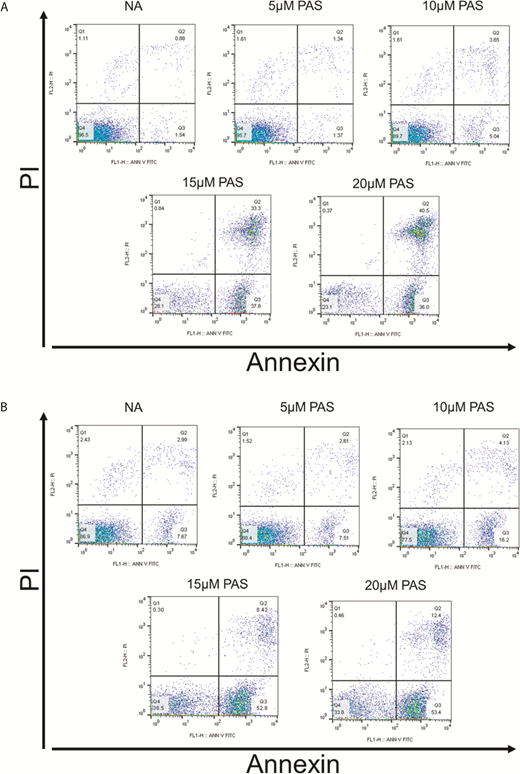In Figure 2A-B on page 1219, the same flow cytometry plots are inadvertently replicated. Due to the time between the publication and the detection of this error, the data for patient AS31 were reanalyzed with FlowJo 10.5.3 rather than with the BD software originally cited. Consequently, the data for patient AS32 were also reanalyzed, resulting in some very minor changes in the percentages of cells in each quadrant for this patient, as shown in the following table.
| Quadrant . | % of cells in each quadrant at PAS concentration (μM) of: . | ||||
|---|---|---|---|---|---|
| 0 . | 5 . | 10 . | 15 . | 20 . | |
| New data | |||||
| Upper left | 2.43 | 1.52 | 2.13 | 0.3 | 0.46 |
| Upper right | 2.99 | 2.61 | 4.13 | 8.42 | 12.4 |
| Lower left | 86.9 | 88.4 | 77.5 | 38.5 | 33.8 |
| Lower right | 7.67 | 7.51 | 16.2 | 52.8 | 53.4 |
| Previous data | |||||
| Upper left | 2.08 | 1.11 | 1.97 | 0.43 | 0.67 |
| Upper right | 1.71 | 1.99 | 4.03 | 9.58 | 13.99 |
| Lower left | 87.52 | 88.13 | 76.4 | 37.38 | 32.47 |
| Lower right | 8.69 | 8.77 | 17.6 | 52.6 | 52.87 |
| Quadrant . | % of cells in each quadrant at PAS concentration (μM) of: . | ||||
|---|---|---|---|---|---|
| 0 . | 5 . | 10 . | 15 . | 20 . | |
| New data | |||||
| Upper left | 2.43 | 1.52 | 2.13 | 0.3 | 0.46 |
| Upper right | 2.99 | 2.61 | 4.13 | 8.42 | 12.4 |
| Lower left | 86.9 | 88.4 | 77.5 | 38.5 | 33.8 |
| Lower right | 7.67 | 7.51 | 16.2 | 52.8 | 53.4 |
| Previous data | |||||
| Upper left | 2.08 | 1.11 | 1.97 | 0.43 | 0.67 |
| Upper right | 1.71 | 1.99 | 4.03 | 9.58 | 13.99 |
| Lower left | 87.52 | 88.13 | 76.4 | 37.38 | 32.47 |
| Lower right | 8.69 | 8.77 | 17.6 | 52.6 | 52.87 |
Annexin V/PI analysis of CLL cells treated with PAS. Cells from patient AS31 with functional p53 (A) or patient AS32 with more than 97% p53 deletion (B) were treated with 0, 5, 10, 15, and 20 μM PAS for 24 hours. Apoptosis was quantified by annexin V/PI FACScan analysis. Values in each quadrant represent the percentage of gated cells in each quarter.
Annexin V/PI analysis of CLL cells treated with PAS. Cells from patient AS31 with functional p53 (A) or patient AS32 with more than 97% p53 deletion (B) were treated with 0, 5, 10, 15, and 20 μM PAS for 24 hours. Apoptosis was quantified by annexin V/PI FACScan analysis. Values in each quadrant represent the percentage of gated cells in each quarter.
The corrected Figure 2 is shown below. Figure 2A has been replaced, while Figure 2B is a reanalysis of the same data. The figure legend is unchanged. Figure 2A is a representative example of a patient with p53 wild-type status and no 17p deletion (17p del), while Figure 2B shows data for a patient with 97% p53 deletion (17p del). This required updating the data in Table 1 (page 1220) for patients AS31 and AS32. The corrected Table 1 is also shown below. These changes do not alter the biological outcome and meaning of the study. The authors apologize for the figure duplication.
Annexin V positivity of CLL cells following incubation with PAS
| Patient no. . | PAS concentration (μM) . | |||
|---|---|---|---|---|
| 5 . | 10 . | 15 . | 20 . | |
| AS8 | 0 | 0 | 0 | 18.2 |
| AS27 | 2.5 | 4.9 | 20.7 | 55.0 |
| AS30 | 0 | ND | 15.3 | 43.1 |
| AS31 | 0.2 | 6.4 | 69.8 | 75.2 |
| AS32 | 0 | 10.5 | 54.8 | 59.7 |
| Patient no. . | PAS concentration (μM) . | |||
|---|---|---|---|---|
| 5 . | 10 . | 15 . | 20 . | |
| AS8 | 0 | 0 | 0 | 18.2 |
| AS27 | 2.5 | 4.9 | 20.7 | 55.0 |
| AS30 | 0 | ND | 15.3 | 43.1 |
| AS31 | 0.2 | 6.4 | 69.8 | 75.2 |
| AS32 | 0 | 10.5 | 54.8 | 59.7 |
CLL cells from 5 patients were incubated with increasing concentrations of PAS for 24 hours. The percentage of annexin V/propidium iodide–positive cells was determined by FACScan analysis. The PAS-specific increase in the percentage of annexin V–positive cells was computed using an established equation.36 ND indicates not determined.


This feature is available to Subscribers Only
Sign In or Create an Account Close Modal